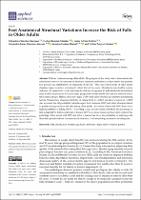Por favor, use este identificador para citar o enlazar este ítem:
https://repositorio.usj.es/handle/123456789/1022
Registro completo de metadatos
| Campo DC | Valor | Lengua/Idioma |
|---|---|---|
| dc.contributor.author | Sanchez-Sanjuan, Almudena | - |
| dc.contributor.author | Romero Morales, Carlos | - |
| dc.contributor.author | Alfaro-Santafe, Javier | - |
| dc.contributor.author | Almenar Arasanz, Alejandro Jesús | - |
| dc.contributor.author | Gomez-Bernal, Antonio | - |
| dc.contributor.author | Pareja-Galeano, Helios | - |
| dc.date.accessioned | 2023-11-29T12:16:46Z | - |
| dc.date.available | 2023-11-29T12:16:46Z | - |
| dc.date.issued | 2022-09-29 | - |
| dc.identifier.citation | Sánchez-Sanjuan, A.; Romero-Morales, C.; Alfaro-Santafé, J.; Almenar-Arasanz, A.-J.; Gómez-Bernal, A.; Pareja-Galeano, H. Foot Anatomical Structural Variations Increase the Risk of Falls in Older Adults. Appl. Sci. 2022, 12, 9825. https://doi.org/10.3390/ app12199825 | en_US |
| dc.identifier.issn | 2076-3417 | en_US |
| dc.identifier.uri | https://repositorio.usj.es/handle/123456789/1022 | - |
| dc.description.abstract | Falls are common among older adults. The purpose of this study was to demonstrate the relationship between foot anatomical structural variations and balance in older adults and quantify foot posture and stabilometry as predictors of fall risk. This case-control study of older adults classified cases or controls according to falls in the last five years. All subjects were healthy women and men > 65 years old (n = 164), who were divided into two groups: 83 individuals who had suffered from a fall in the previous five years (case group) and 81 individuals who had not suffered from a fall (control group). Hallux abductus valgus (HAV) and tailor’s bunion are stability-determining factors. Women have a higher probability of falling. HAV (p = 0.042) and tailor’s bunion (p = 0.069) also increased the fall probability. Morphological foot variations (HAV and tailor’s bunion) linked to gender and age increase fall risk among older adults. In women fallers with HAV, there was a higher possibility of falling (63.9%). According to age, in older adults with HAV, the percentage of falls is high (62%). Fallers with tailor’s bunion (60.7%) are more numerous than fallers without this pathology. Older adults with HAV and tailor´s bunion had twice the probability of suffering a fall than older people without foot anatomical structural. Foot morphology is decisive in falling risk. | en_US |
| dc.format.extent | 9 p. | en_US |
| dc.format.mimetype | application/pdf | en_US |
| dc.language.iso | eng | en_US |
| dc.publisher | MDPI | en_US |
| dc.rights | Atribución 4.0 Internacional | * |
| dc.rights.uri | http://creativecommons.org/licenses/by/4.0/ | * |
| dc.subject | Falls | en_US |
| dc.subject | Elderly | en_US |
| dc.subject | Foot morphology | en_US |
| dc.subject | Hallux abductus valgus | en_US |
| dc.subject | Tailor’s bunion | en_US |
| dc.subject | Gender | en_US |
| dc.title | Foot Anatomical Structural Variations Increase the Risk of Falls in Older Adults | en_US |
| dc.type | journal article | es_ES |
| dc.identifier.doi | https://doi.org/10.3390/ app12199825 | en_US |
| dc.rights.accessRights | open access | es_ES |
| Aparece en las colecciones: | Artículos de revistas | |
Ficheros en este ítem:
| Fichero | Descripción | Tamaño | Formato | |
|---|---|---|---|---|
| Foot Anatomical Structural Variations Increase the Risk of Falls in Older Adults.pdf | 273,23 kB | Adobe PDF |  Visualizar/Abrir |
Este ítem está sujeto a una licencia Creative Commons Licencia Creative Commons

